- Importance of an Effective Healthcare Website
- What is the Specialty of A Healthcare Website
- Understanding the Unique Needs of Healthcare Organizations While Designing And Developing A Website For Their Business
- How Healthcare Website Design Differs from Other Website Design
- Importance of User-Centric Design for Healthcare Websites
- Responsive Healthcare Website Design for Seamless User Experience
- Healthcare Website Design Customization for Brand Identity and Business Objectives
- Importance of Patient-Centric Features in Healthcare Website for Enhanced Engagement
- Approach we follow Healthcare Website Design and Development
- Ensuring HIPAA Compliance in Healthcare Websites Designed By Webrock Media
- Our Focus On Search Engine Optimization (SEO) for Improved Visibility of Healthcare Website Design
- Ongoing Support and Maintenance for Website Performance
- Integration Capabilities in Healthcare Website Design for Streamlined Operations
- Scalability and Future-Proofing Via Website Design and Development for Healthcare Organizational Growth
- Why Choose Webrock Media for Healthcare Website Design and Development?
Key Principles for Designing a Patient-Centric Healthcare Website
home / blog / Key Principles for Designing a Patient-Centric Healthcare Website
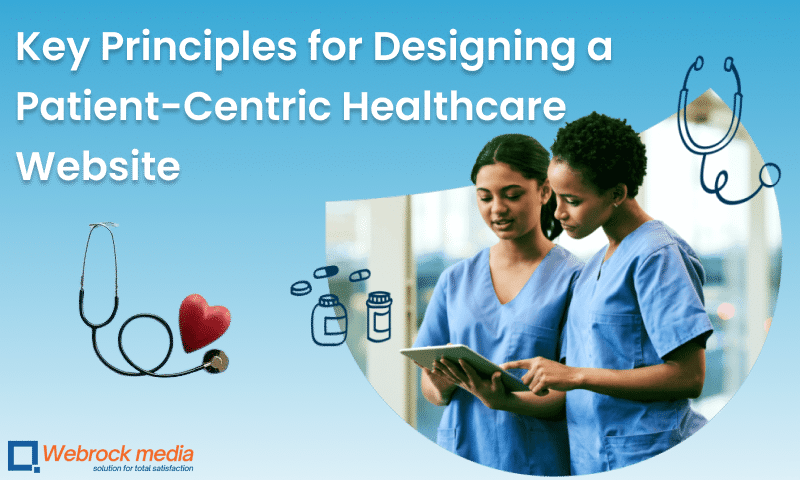
Webrock Media offers best-in-class healthcare website design services at competitive prices to help you establish your brand name in the industry and offer an engaging user experience.
A healthcare website design refers to the visual and functional elements of a website specifically tailored for the healthcare industry. It focuses on creating a user-friendly and intuitive online platform to provide information, services, and resources related to healthcare. We at Webrock Media offer you superior quality website design services at affordable prices.
A healthcare website design refers to the process of creating a visually appealing and user-friendly online platform specifically tailored for the healthcare industry. It goes beyond aesthetics and focuses on effectively communicating medical information, providing services, and engaging with patients and visitors. A well-designed healthcare website serves as a valuable resource for patients, medical professionals, and other stakeholders in the healthcare ecosystem.
In terms of aesthetics, a healthcare website layout typically features a clean and professional look, utilizing a color scheme and typography that evoke trust and credibility. The design elements should align with the branding of the healthcare organization, conveying a sense of professionalism and expertise. The layout should be intuitive and organized, with a clear navigation structure that allows visitors to easily find the information they need.
Moreover, a crucial aspect of healthcare website design is ensuring usability and accessibility. The design should prioritize user experience, making it easy for patients to navigate through the site, find relevant information, and access services such as appointment scheduling or patient portals. It should also be responsive, adapting to different screen sizes and devices, including smartphones and tablets. Additionally, attention to web accessibility standards ensures that individuals with disabilities can access and interact with the website effectively.
Overall, a well-executed healthcare website combines aesthetics, usability, and accessibility to create an engaging and informative online platform. It aims to empower patients, facilitate communication between healthcare providers and individuals, and ultimately improve the delivery and accessibility of healthcare services.
Importance of an Effective Healthcare Website
- Importance of an Effective Healthcare Website
- What is the Specialty of A Healthcare Website
- Understanding the Unique Needs of Healthcare Organizations While Designing And Developing A Website For Their Business
- How Healthcare Website Design Differs from Other Website Design
- Importance of User-Centric Design for Healthcare Websites
- Responsive Healthcare Website Design for Seamless User Experience
- Healthcare Website Design Customization for Brand Identity and Business Objectives
- Importance of Patient-Centric Features in Healthcare Website for Enhanced Engagement
- Approach we follow Healthcare Website Design and Development
- Ensuring HIPAA Compliance in Healthcare Websites Designed By Webrock Media
- Our Focus On Search Engine Optimization (SEO) for Improved Visibility of Healthcare Website Design
- Ongoing Support and Maintenance for Website Performance
- Integration Capabilities in Healthcare Website Design for Streamlined Operations
- Scalability and Future-Proofing Via Website Design and Development for Healthcare Organizational Growth
- Why Choose Webrock Media for Healthcare Website Design and Development?
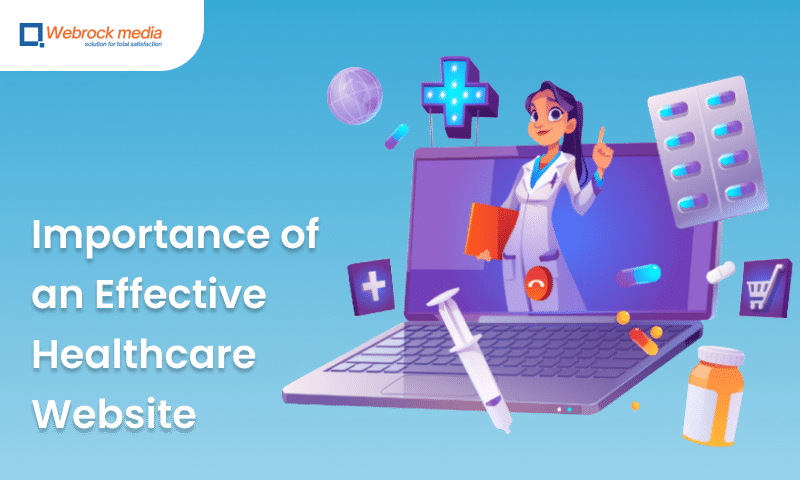
An effective healthcare website plays a crucial role in today’s digital era. It serves as a powerful tool for healthcare providers, patients, and other stakeholders in the healthcare industry. Here are some key reasons why an effective healthcare website is important:
- Accessibility and Convenience:
A well-designed healthcare website provides easy access to information, services, and resources. Patients can conveniently find information about medical conditions, treatment options, healthcare providers, and facilities without the need for physical visits or phone calls. This accessibility enhances patient experience and empowers individuals to make informed decisions about their healthcare.
- Patient Education:
Healthcare websites offer a platform to educate patients about various medical topics, preventive care, lifestyle choices, and self-management of conditions. Accessible and accurate information empowers patients to understand their health better, participate in shared decision-making, and actively engage in their own care.
- Appointment Booking and Online Services:
An effective healthcare website enables patients to book appointments online, request prescription refills, access test results, and communicate with healthcare providers through secure messaging systems. These online services enhance convenience, reduce administrative burdens, and improve overall patient satisfaction.
- Health Promotion and Disease Prevention:
Healthcare websites can promote healthy lifestyles, provide information on disease prevention, and offer resources for managing chronic conditions. They can include wellness tips, healthy recipes, exercise routines, and preventive screening guidelines, encouraging individuals to take proactive steps towards their well-being.
- Trust and Credibility:
A professionally designed healthcare website instills trust and confidence in patients. It showcases the expertise, qualifications, and achievements of healthcare professionals and organizations. Well-presented information, testimonials, patient reviews, and relevant accreditations contribute to establishing credibility and attracting potential patients.
- Online Community and Support:
Healthcare websites can incorporate features such as patient forums, support groups, or chat functionalities to foster an online community. This enables patients to connect with others who share similar health concerns, exchange experiences, and provide emotional support. Online support can be especially beneficial for individuals with rare conditions or those who feel isolated.
- Marketing and Branding:
Healthcare websites serve as a valuable marketing tool for healthcare providers and organizations. An effective website can help build a strong brand presence, differentiate services from competitors, and attract new patients. It allows healthcare providers to showcase their expertise, specialties, and unique offerings.
- Research and Resources:
Healthcare websites can provide access to research articles, medical guidelines, patient handouts, and other educational resources. These resources aid healthcare professionals in staying updated with the latest advancements in their field and assist patients in understanding complex medical information.
An effective healthcare website enhances accessibility, empowers patients, provides valuable resources, and strengthens the overall healthcare experience. It is an essential component of modern healthcare delivery, facilitating communication, education, and convenience for patients, providers, and the broader healthcare community.
What is the Specialty of A Healthcare Website
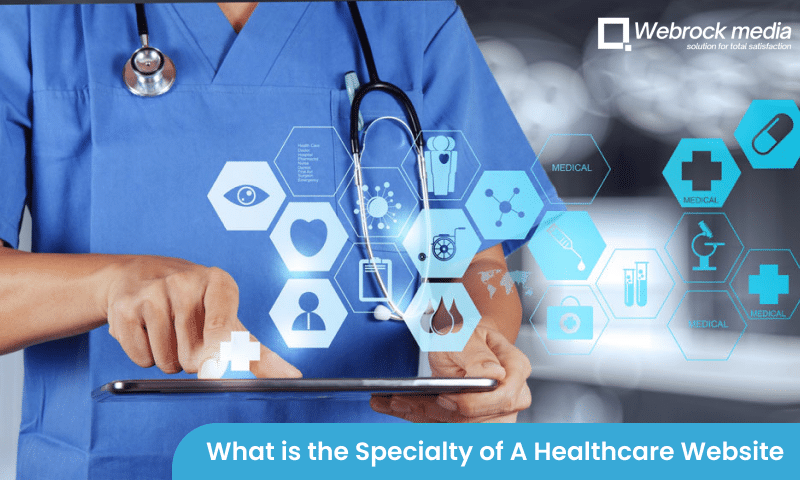
The specialty of a healthcare service website can vary depending on its focus and purpose. However, in general, a healthcare service website specializes in providing information, resources, and services related to healthcare. Some common specialties of healthcare service websites include:
- Medical Information:
Many healthcare service websites specialize in providing reliable and up-to-date medical information on various health conditions, diseases, treatments, medications, and procedures. These websites aim to educate and inform users about different aspects of healthcare.
- Appointment Booking:
Some healthcare service websites specialize in allowing users to book appointments with healthcare professionals, such as doctors, dentists, or specialists. These websites often provide a convenient and user-friendly interface for scheduling appointments, managing calendars, and even sending reminders.
- Telemedicine Services:
With the rise of telehealth, certain healthcare service websites specialize in providing virtual consultations and remote medical services. They may offer video or phone consultations, allowing patients to seek medical advice or treatment from the comfort of their homes.
- Health and Wellness Resources:
Several healthcare service websites focus on promoting health and wellness by providing resources on nutrition, exercise, mental health, preventive care, and lifestyle management. They may offer articles, tips, tools, and interactive features to help users improve their overall well-being.
- Patient Support and Communities:
Some healthcare service websites specialize in creating online communities and support networks for patients and their families. These websites often provide forums, chat rooms, or social media platforms where individuals can connect, share experiences, seek advice, and offer support to others facing similar health challenges.
- Health Insurance and Financial Assistance:
Certain healthcare service websites specialize in providing information and resources related to health insurance plans, coverage options, and financial assistance programs. They may help users understand their insurance benefits, compare plans, and navigate the complexities of healthcare costs.
It’s important to note that these specialties can often overlap, and many healthcare service websites provide a combination of these features to cater to the diverse needs of their users.
Understanding the Unique Needs of Healthcare Organizations While Designing And Developing A Website For Their Business
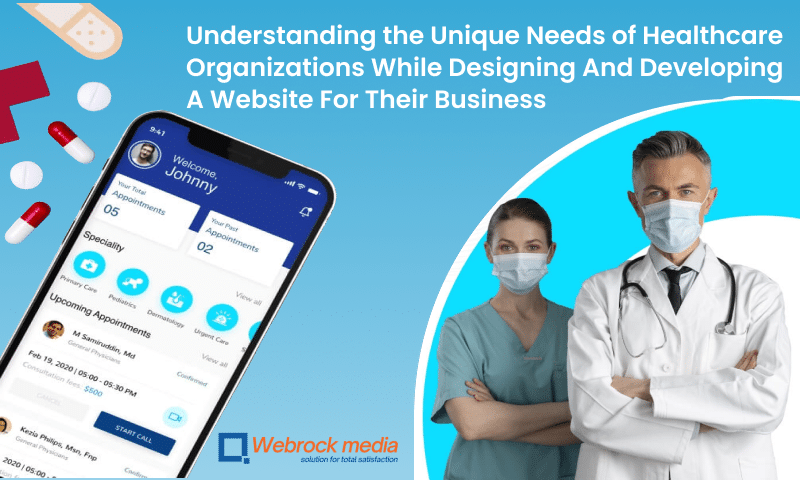
When designing and developing a website for a healthcare organization, it is crucial to consider their unique needs and requirements. By understanding and addressing these unique needs of healthcare organizations, you can create a website that not only meets their requirements but also enhances patient experience, privacy, and trust. Collaborating closely with the organization’s stakeholders, including healthcare providers, IT teams, and compliance officers, is essential to ensure a successful website development process. Here are some key aspects to keep in mind:
- Compliance with Regulatory Standards:
Healthcare organizations must comply with various regulatory standards, such as HIPAA (Health Insurance Portability and Accountability Act) in the United States or GDPR (General Data Protection Regulation) in the European Union. It is essential to design the website with strict adherence to these regulations to ensure patient privacy and data security.
- Patient Privacy and Confidentiality:
Privacy and confidentiality are paramount in healthcare. The website should have robust security measures in place to protect sensitive patient information. Use secure protocols (HTTPS), implement encryption techniques, and incorporate authentication mechanisms to ensure the confidentiality of patient data.
- User-friendly Interface:
Healthcare websites should have a user-friendly interface that is easy to navigate, with intuitive menus and clear information hierarchy. Patients and visitors should be able to find the information they need quickly and efficiently. Consider the target audience’s demographics and design the website accordingly, keeping in mind factors such as age, language preferences, and accessibility requirements.
- Mobile Responsiveness:
With the increasing use of mobile devices, it is crucial to design the website to be mobile-responsive. The website should automatically adjust its layout and content to fit different screen sizes and resolutions, providing a seamless user experience across desktops, tablets, and smartphones.
- Appointment Scheduling and Online Services:
Incorporate features that allow patients to schedule appointments online, access medical records, request prescription refills, and communicate securely with healthcare providers. These online services enhance convenience and efficiency for patients and improve administrative workflows for healthcare organizations.
- Clear and Concise Information:
Present information in a clear and concise manner. Healthcare websites should provide accurate and up-to-date information about services, medical conditions, treatments, and healthcare providers. Use plain language to explain complex medical terms and concepts, making it accessible to a wide range of audiences.
- Integration with Electronic Health Records (EHR):
If applicable, integrate the website with the organization’s electronic health record system. This integration can streamline processes, enable secure data exchange, and provide patients with seamless access to their medical information.
- Trust and Credibility:
Healthcare websites should convey trust and credibility. Highlight the qualifications, expertise, and experience of healthcare providers and showcase any relevant certifications or accreditations. Include patient testimonials, success stories, and quality indicators to build trust with potential patients.
- Multilingual and Multicultural Considerations:
In diverse healthcare settings, consider offering website content in multiple languages to accommodate patients with different language preferences. Also, be mindful of cultural considerations, such as visual elements, colors, and symbols, to ensure the website resonates with the target audience.
- Integration with Online Marketing and SEO:
Incorporate search engine optimization (SEO) strategies to improve the website’s visibility in search engine results. Implement online marketing techniques, such as content marketing and social media integration, to promote the website and attract potential patients.
How Healthcare Website Design Differs from Other Website Design
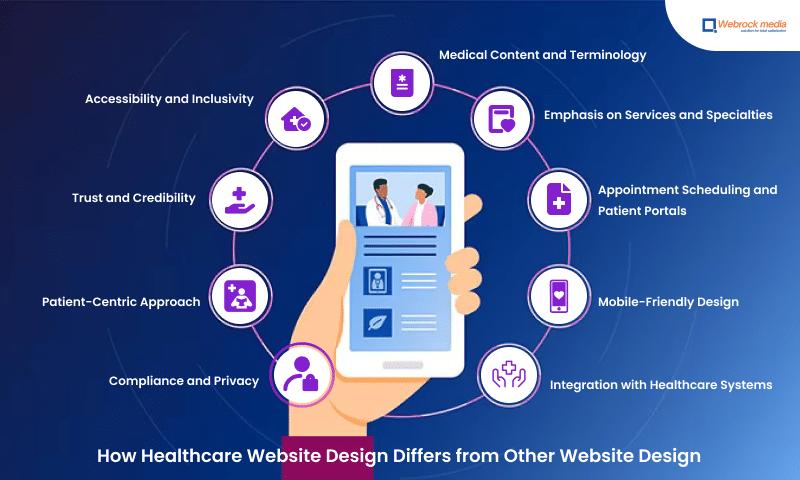
Healthcare website design differs from other website designs in several key ways due to the unique nature and requirements of the healthcare industry. Here are some factors that distinguish healthcare website design:
- Compliance and Privacy:
Healthcare websites must adhere to strict regulations and compliance standards, such as the Health Insurance Portability and Accountability Act (HIPAA) in the United States. Design considerations must include ensuring the privacy and security of patient data, implementing proper consent mechanisms, and incorporating measures to protect sensitive health information.
- Patient-Centric Approach:
Healthcare websites are primarily focused on providing information, resources, and services to patients. The design should prioritize a user-centric approach, making it easy for patients to find relevant information, access patient portals, schedule appointments, access educational materials, and engage in other patient-centered activities.
- Trust and Credibility:
Healthcare websites need to inspire trust and convey credibility to patients. This can be achieved through professional and authoritative design elements, such as using high-quality medical imagery, showcasing certifications, displaying testimonials, and highlighting the expertise and credentials of healthcare professionals.
- Accessibility and Inclusivity:
Healthcare websites should prioritize accessibility to accommodate users with different abilities and disabilities. This includes ensuring compliance with accessibility guidelines, providing alternative text for images, offering text-to-speech functionality, and designing with color contrasts that are easily readable for individuals with visual impairments.
- Medical Content and Terminology:
Healthcare websites often contain complex medical information that needs to be presented in a user-friendly and understandable manner. Design considerations may include clear typography, effective use of headings and subheadings, visual aids such as diagrams or infographics, and the use of plain language to convey medical concepts.
- Emphasis on Services and Specialties:
Healthcare websites typically highlight the services, specialties, and healthcare providers associated with the organization. Design elements should showcase these aspects prominently, allowing patients to easily navigate and explore the various services offered.
- Appointment Scheduling and Patient Portals:
Many healthcare websites include functionality for appointment scheduling and patient portals. The design should incorporate intuitive interfaces for these features, allowing patients to schedule appointments, view test results, access medical records, and communicate securely with healthcare providers.
- Mobile-Friendly Design:
With the increasing use of mobile devices, healthcare websites must be designed to be responsive and mobile-friendly. The design should adapt to different screen sizes and resolutions, ensuring a consistent and optimized experience for users accessing the website on smartphones or tablets.
- Integration with Healthcare Systems:
Healthcare websites often require integration with various healthcare systems, such as electronic health records (EHR), appointment scheduling, or telemedicine platforms. Design considerations include seamless integration of these systems, ensuring a cohesive and efficient user experience.
Healthcare website design needs to prioritize compliance, patient-centricity, trust, accessibility, medical content presentation, service emphasis, appointment scheduling, mobile-friendliness, and integration with healthcare systems. Understanding these unique requirements is essential to create effective and user-friendly websites in the healthcare industry.
Importance of User-Centric Design for Healthcare Websites

User-centric design is crucial for healthcare websites as it focuses on enhancing user experience, empowering patients, improving communication, ensuring accessibility, streamlining tasks, building trust, and enabling iterative improvement. By prioritizing the needs and preferences of website users, healthcare organizations can create websites that effectively serve their target audience and contribute to improved patient engagement and outcomes. User-centric design is of paramount importance when designing healthcare websites. Here’s why:
- Enhanced User Experience:
User-centric design focuses on creating a positive and seamless experience for website visitors. In the healthcare context, this means making it easy for patients and users to find the information they need, navigate the website intuitively, and accomplish their goals efficiently. By understanding user behaviors, preferences, and needs, a user-centric approach ensures that the website is intuitive, accessible, and provides a pleasant experience.
- Patient Empowerment:
Healthcare websites play a crucial role in empowering patients to actively participate in their healthcare journey. By prioritizing user-centric design principles, websites can offer user-friendly features such as appointment booking, access to medical records, online communication with healthcare providers, and educational resources. These capabilities empower patients to take control of their health, make informed decisions, and engage in shared decision-making with their healthcare providers.
- Clear Communication:
User-centric design ensures that healthcare information is presented in a clear, concise, and understandable manner. It takes into account the diverse backgrounds, health literacy levels, and language preferences of the website’s users. By using plain language, visual aids, and appropriate formatting, user-centric design helps convey complex medical information effectively, improving comprehension and reducing confusion.
- Accessibility and Inclusivity:
Healthcare websites need to be accessible to individuals with disabilities or impairments. User-centric design ensures that the website meets accessibility standards, such as providing alternative text for images, proper heading structure, and keyboard accessibility. It considers the needs of users with visual, hearing, motor, or cognitive impairments, making the website inclusive and ensuring that everyone can access and benefit from its content and functionality.
- Efficient Task Completion:
A user-centric design approach focuses on streamlining processes and facilitating efficient task completion. For example, if a patient wants to schedule an appointment, the website should guide them through a simple and intuitive process, minimizing the number of steps and reducing friction. By prioritizing user needs and expectations, the design eliminates unnecessary complexities and ensures that tasks can be completed quickly and easily.
- Trust and Credibility:
User-centric design contributes to building trust and credibility with website users. A well-designed website that is easy to use, visually appealing, and provides accurate and reliable information fosters trust in the healthcare organization and its services. By demonstrating a user-centered approach, the website conveys a commitment to patient-centric care, professionalism, and quality.
- Iterative Improvement:
User-centric design involves ongoing evaluation and improvement based on user feedback and analytics. By collecting and analyzing user data, healthcare organizations can identify pain points, areas of confusion, and opportunities for optimization. This iterative process allows for continuous improvement of the website, ensuring that it remains aligned with user needs and expectations over time.
Responsive Healthcare Website Design for Seamless User Experience
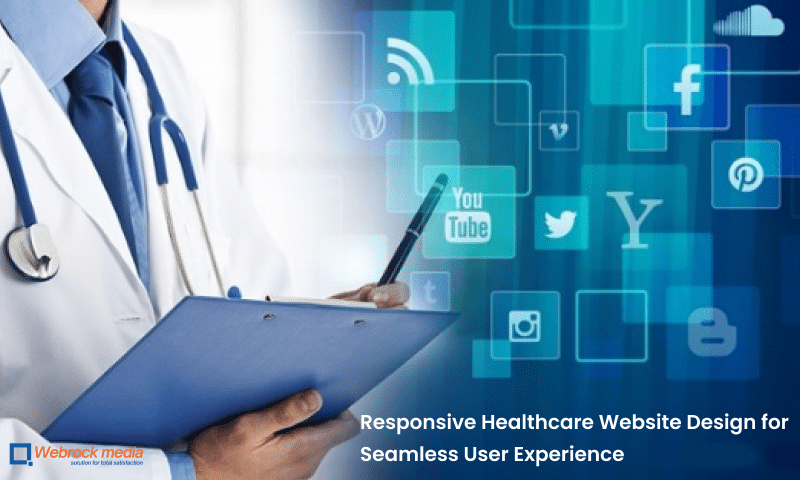
Responsive healthcare website design is essential for delivering a seamless user experience across different devices and screen sizes. Here are key considerations for creating a responsive healthcare website:
- Mobile-Friendly Layout:
Design the website to automatically adapt its layout to different screen sizes, ensuring optimal viewing and interaction on smartphones and tablets. Use a responsive grid system that adjusts content and elements proportionally, maintaining readability and usability on smaller screens.
- Flexible Images and Media:
Optimize images and media files to load quickly and adjust their size based on the screen resolution. Implement responsive image techniques like using CSS media queries and HTML attributes to serve appropriately sized images based on the user’s device.
- Intuitive Navigation:
Simplify navigation for mobile devices by using a menu that is easy to access and navigate with a touch interface. Consider implementing a collapsible menu or a hamburger menu icon to save screen space while providing access to important sections of the website.
- Readability and Font Sizes:
Ensure that the website content is legible on different devices by using a font size and type that are easily readable on smaller screens. Maintain adequate line spacing and contrast to enhance readability, and avoid using small fonts or long blocks of text that may strain the user’s eyes.
- Touch-Friendly Elements:
Design interactive elements, such as buttons and links, to accommodate touch interactions. Ensure that they are large enough and have enough spacing between them to prevent accidental taps or clicks.
- Streamlined Forms:
Simplify and optimize forms for mobile users by minimizing the number of input fields and utilizing mobile-friendly input options like dropdowns and checkboxes. Use responsive design techniques to adjust the form layout based on the device’s screen size.
- Performance Optimization:
Mobile users may have limited bandwidth and slower internet connections, so optimize the website’s performance to minimize page load times. Compress images, use caching techniques, and minimize the use of unnecessary scripts or plugins to improve overall website performance.
- Consistent Branding:
Maintain consistent branding elements, such as logos, colors, and typography, across different devices. Ensure that the website design reflects the organization’s visual identity and reinforces brand recognition.
- Device and Browser Compatibility:
Test the website on various devices, operating systems, and web browsers to ensure compatibility and functionality across different platforms. Address any issues or inconsistencies that may arise to provide a consistent experience to all users.
- User Testing and Feedback:
Conduct user testing and gather feedback from real users on different devices to identify potential usability issues and areas for improvement. Incorporate user feedback into the design process to enhance the overall user experience.
By implementing responsive design principles, healthcare websites can deliver a seamless user experience regardless of the device being used. This approach improves accessibility, usability, and engagement, ultimately leading to better patient satisfaction and increased website effectiveness.
Healthcare Website Design Customization for Brand Identity and Business Objectives
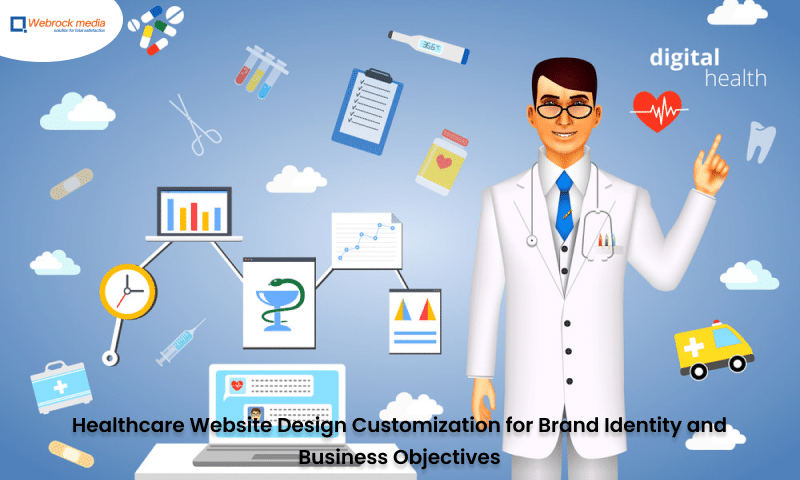
Customizing healthcare website design to align with brand identity and business objectives is crucial for establishing a unique online presence and achieving organizational goals. Here are some considerations for customization:
- Visual Branding:
Incorporate visual elements that reflect the healthcare organization’s brand identity, such as logos, color schemes, typography, and imagery. Consistency in branding across the website helps reinforce brand recognition and fosters a sense of trust and familiarity with users.
- Tone and Voice:
Customize the website’s content and messaging to reflect the organization’s unique tone and voice. Whether it’s formal, friendly, authoritative, or compassionate, the language used should align with the brand’s personality and resonate with the target audience.
- Unique Value Proposition:
Highlight the organization’s unique value proposition prominently on the website. Clearly communicate what sets the healthcare organization apart from competitors, emphasizing the benefits and advantages that patients can expect by choosing their services.
- Call-to-Action (CTA):
Strategically place CTAs throughout the website to guide users towards desired actions, such as scheduling an appointment, requesting a consultation, or accessing specific resources. Customize the design, placement, and language of CTAs to align with business objectives and user needs.
- Information Architecture:
Customize the website’s structure and navigation to support the organization’s specific goals and user journeys. Prioritize the most important sections, services, and resources based on business objectives, ensuring intuitive navigation and easy access to critical information.
- Patient Testimonials and Success Stories:
Incorporate patient testimonials and success stories to build trust and credibility. Customize the presentation of these testimonials to align with the website’s design and emphasize positive patient experiences and outcomes.
- Services and Specialties:
Highlight the organization’s range of services, specialties, and expertise in a visually appealing and easily accessible manner. Customize the presentation of services to effectively communicate the organization’s capabilities and address the unique needs of the target audience.
- Content Strategy:
Develop a content strategy that aligns with business objectives, target audience needs, and search engine optimization (SEO) goals. Customize the content to provide valuable and relevant information that educates and engages users while promoting the organization’s expertise and services.
- Conversion Tracking and Analytics:
Implement tracking mechanisms and analytics tools to measure and analyze user behavior, engagement, and conversions on the website. Customize analytics reports to align with specific business objectives, enabling data-driven decision-making and ongoing optimization efforts.
- Responsive Design:
Ensure that the customization efforts extend to responsive design, delivering a consistent and seamless user experience across different devices and screen sizes. Customization should account for the specific requirements and constraints of mobile devices to optimize user engagement and satisfaction.
By customizing healthcare website design to reflect brand identity and align with business objectives, organizations can create a unique and impactful online presence. The customization process should be guided by a thorough understanding of the target audience, business goals, and industry trends to maximize the effectiveness of the website in attracting and engaging patients.
Importance of Patient-Centric Features in Healthcare Website for Enhanced Engagement
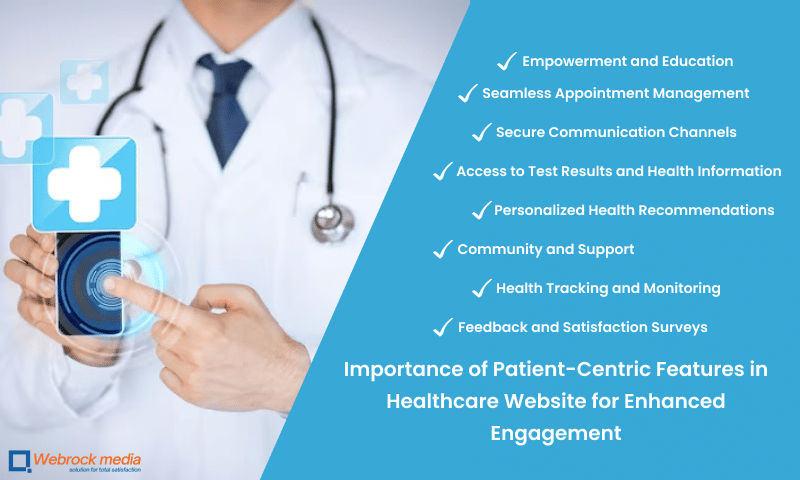
Patient-centric features in healthcare websites play a vital role in enhancing patient engagement and improving the overall healthcare experience. Here are some key reasons why these features are important:
- Empowerment and Education:
Patient-centric features provide tools and resources that empower patients to take an active role in their healthcare. Features such as access to personal health records, educational materials, and self-care resources enable patients to make informed decisions, manage their health effectively, and participate in shared decision-making with healthcare providers.
- Seamless Appointment Management:
Online appointment scheduling and management features make it convenient for patients to book, reschedule, or cancel appointments. These features reduce administrative burdens and wait times, enhancing patient satisfaction and engagement. Additionally, automated reminders and notifications help patients stay informed and prepared for their appointments.
- Secure Communication Channels:
Patient-centric websites often incorporate secure messaging systems that enable patients to communicate directly with healthcare providers. This feature facilitates timely and convenient communication, allowing patients to ask questions, request prescription refills, receive follow-up care instructions, and seek clarification on treatment plans. Improved communication strengthens the patient-provider relationship and promotes engagement.
- Access to Test Results and Health Information:
Providing patients with access to their test results, lab reports, and other relevant health information through the website enhances transparency and enables patients to actively manage their health. This feature allows patients to review their results, track progress, and seek further clarification if needed, promoting a collaborative approach to healthcare.
- Personalized Health Recommendations:
Websites with patient-centric features can utilize algorithms and data analysis to offer personalized health recommendations and preventive care reminders. By considering a patient’s medical history, risk factors, and preferences, the website can provide tailored information and reminders for screenings, vaccinations, and lifestyle modifications, promoting proactive health management.
- Community and Support:
Patient-centric websites can incorporate community forums or support groups where patients can connect with others facing similar health challenges. These interactive features create a sense of belonging, provide emotional support, and encourage knowledge-sharing among patients. Building a supportive community fosters engagement, resilience, and improved overall well-being.
- Health Tracking and Monitoring:
Websites with patient-centric features may integrate with wearable devices or health tracking apps, allowing patients to monitor and track their health parameters such as heart rate, blood pressure, or physical activity. This data can be securely shared with healthcare providers for remote monitoring and timely interventions, fostering engagement and proactive healthcare management.
- Feedback and Satisfaction Surveys:
Patient-centric websites often include mechanisms for patients to provide feedback and participate in satisfaction surveys. This feedback helps healthcare organizations understand patient needs, identify areas for improvement, and deliver better services. By actively involving patients in the feedback process, the website promotes a patient-centered approach and demonstrates a commitment to continuous improvement.
Patient-centric features in healthcare websites empower patients, facilitate seamless communication, provide access to information and resources, foster community support, and enable personalized care. By incorporating these features, healthcare organizations can enhance patient engagement, improve patient satisfaction, and ultimately deliver more patient-centered care.
Approach we follow Healthcare Website Design and Development

At Webrock Media, we specialize in designing and developing healthcare websites that are tailored to meet the unique needs of healthcare providers, clinics, hospitals, and other healthcare organizations. With our extensive experience and expertise in web design and development, we understand the critical role that a well-designed website plays in the success of healthcare businesses in today’s digital age.
Our Approach to Healthcare Website Design and Development
- User-Centric Design:
We prioritize the user experience and ensure that our healthcare websites are intuitive, easy to navigate, and visually appealing. We create user-centric designs that enhance engagement and provide seamless access to essential information and services.
- Responsive Design:
With the increasing use of mobile devices, we develop healthcare websites that are fully responsive. This ensures that your website will adapt to different screen sizes and devices, providing a consistent and optimal user experience across desktops, tablets, and smartphones.
- Customized Solutions:
We understand that every healthcare organization has its unique requirements and goals. Our team works closely with you to understand your specific needs and develop a custom website solution that aligns with your brand identity and business objectives.
- Patient-Centric Features:
We integrate patient-centric features into your healthcare website to enhance patient engagement and satisfaction. These may include online appointment scheduling, patient portals for accessing medical records, secure messaging systems for communication, and interactive educational resources.
- HIPAA Compliance:
We prioritize data security and confidentiality in healthcare website development. Our team ensures that your website complies with HIPAA regulations, safeguarding patient information and maintaining privacy standards.
- Search Engine Optimization (SEO):
We employ effective SEO strategies to optimize your healthcare website for search engines. This helps improve your website’s visibility, organic rankings, and overall online presence, leading to increased website traffic and potential patient leads.
- Integration Capabilities:
Our healthcare websites can seamlessly integrate with existing healthcare management systems, electronic medical records (EMR) software, appointment scheduling systems, and other relevant third-party applications, streamlining operations and enhancing efficiency.
- Scalability and Future-Proofing:
We build scalable websites that can accommodate your future growth and evolving needs. Our team stays up-to-date with the latest web technologies and industry trends, ensuring that your healthcare website remains current and future-proofed.
- Ongoing Support and Maintenance:
Our partnership does not end with website deployment. We offer ongoing support and maintenance services, including security updates, website backups, performance monitoring, and content management system (CMS) training, to ensure your website remains secure, up-to-date, and optimized.
Ensuring HIPAA Compliance in Healthcare Websites Designed By Webrock Media
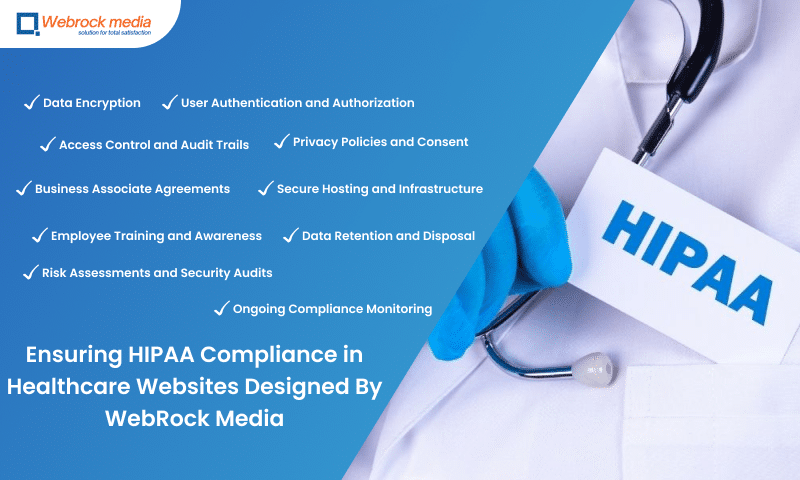
When designing healthcare websites, it is crucial to ensure compliance with HIPAA (Health Insurance Portability and Accountability Act) regulations to protect patient privacy and maintain data security. Here are some steps that Webrock Media can take to ensure HIPAA compliance:
- Data Encryption:
Implement strong encryption protocols, such as SSL/TLS, to secure data transmission between the website and users. Encrypt sensitive patient information both in transit and at rest to prevent unauthorized access.
- User Authentication and Authorization:
Incorporate robust user authentication mechanisms to ensure that only authorized individuals can access patient data. Implement secure login processes, strong password policies, and multi-factor authentication to protect user accounts.
- Access Control and Audit Trails:
Set up access controls to restrict user access to patient information based on their roles and responsibilities. Maintain detailed audit logs to track and monitor user activities, including who accessed what data and when. Regularly review and analyze these logs to detect any unauthorized access or suspicious activity.
- Privacy Policies and Consent:
Create comprehensive privacy policies that outline how patient data is collected, stored, and used on the website. Obtain patient consent for data collection and clearly communicate the purpose and scope of data usage to patients.
- Business Associate Agreements:
Ensure that any third-party service providers or vendors involved in the website development or hosting process sign a Business Associate Agreement (BAA). This agreement establishes their commitment to handling patient data in compliance with HIPAA regulations.
- Secure Hosting and Infrastructure:
Select a hosting provider that offers HIPAA-compliant infrastructure, including secure servers, regular backups, and robust physical and network security measures. Regularly update and patch software and implement intrusion detection and prevention systems to safeguard against cyber threats.
- Employee Training and Awareness:
Conduct HIPAA training sessions for all employees involved in the website design and development process. Ensure they understand the importance of patient privacy, their responsibilities in safeguarding data, and the consequences of non-compliance.
- Data Retention and Disposal:
Establish policies and procedures for data retention and disposal in compliance with HIPAA guidelines. Regularly review and securely dispose of outdated or unnecessary patient data to minimize the risk of unauthorized access or data breaches.
- Risk Assessments and Security Audits:
Conduct regular risk assessments and security audits to identify vulnerabilities and gaps in security controls. Address any identified issues promptly and implement necessary security measures to mitigate risks.
- Ongoing Compliance Monitoring:
Continuously monitor the website and its associated systems for compliance with HIPAA regulations. Stay updated on changes in regulations and best practices to ensure ongoing compliance.
Webrock Media can help healthcare organizations achieve HIPAA compliance in the design and development of healthcare websites. It is important to work closely with the healthcare organization’s compliance and IT teams to ensure all necessary measures are in place to protect patient privacy and maintain data security.
Our Focus On Search Engine Optimization (SEO) for Improved Visibility of Healthcare Website Design
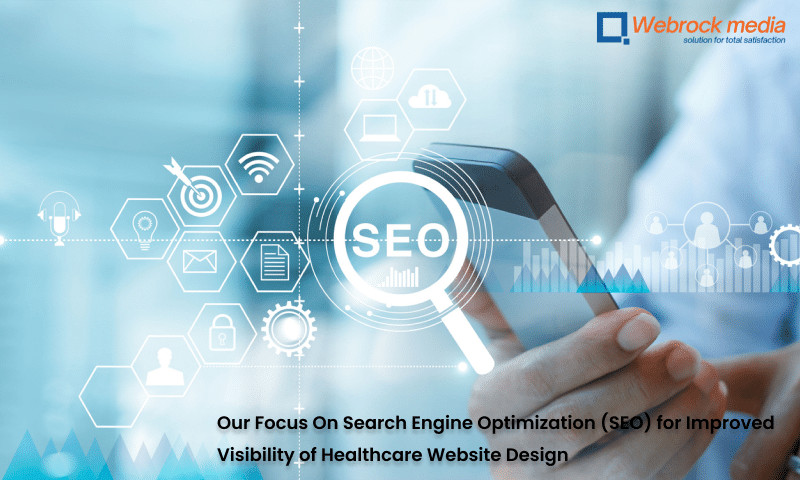
Focusing on search engine optimization (SEO) for healthcare website design is crucial for improving its visibility and attracting organic traffic. Here are some key considerations for optimizing a healthcare website for search engines:
- Keyword Research:
Identify relevant keywords and key phrases that potential patients may use when searching for healthcare services. Consider specific treatments, medical specialties, or location-based keywords. Conduct keyword research to understand search volume, competition, and user intent. Incorporate these keywords naturally throughout the website’s content, including page titles, headings, meta descriptions, and body text.
- High-Quality Content:
Create informative and valuable content that addresses the needs and concerns of the target audience. Develop content that answers common healthcare questions, provides educational resources, and offers insights into various medical conditions or treatments. Use a mix of formats such as articles, blog posts, videos, infographics, and patient stories. Ensure content is well-structured, easily readable, and optimized for relevant keywords.
- On-Page Optimization:
Optimize on-page elements to improve search engine visibility. This includes optimizing meta tags (titles and descriptions) for each page, using relevant headings (H1, H2, etc.) to structure content, and incorporating keywords naturally in the content. Use descriptive and user-friendly URLs and optimize image alt tags for accessibility and SEO purposes.
- Mobile-Friendly Design:
With the increasing use of mobile devices, it’s important to ensure the healthcare website is mobile-friendly and responsive. Search engines prioritize mobile-friendly websites in search results. Make sure the website design adapts to different screen sizes, loads quickly, and provides a seamless user experience on mobile devices.
- Local SEO:
If the healthcare organization operates in specific geographical areas, optimize the website for local SEO. Include location-specific keywords and create dedicated pages for each location served. Register the website with Google My Business and other online directories, ensuring accurate and consistent NAP (Name, Address, Phone) information.
- Backlink Building:
Earn high-quality backlinks from reputable websites to improve the website’s authority and search engine rankings. Develop relationships with other healthcare organizations, medical associations, and industry influencers who can link to the website’s content. Focus on creating valuable and shareable content that naturally attracts backlinks.
- Technical Optimization:
Ensure the website’s technical aspects are optimized for SEO. This includes optimizing site speed, improving website navigation and user experience, optimizing site architecture, using structured data markup to enhance search engine understanding, and implementing proper URL canonicalization.
- Online Reviews and Reputation Management:
Encourage patients to leave reviews and ratings on reputable platforms such as Google My Business, Yelp, or Healthgrades. Positive reviews and high ratings can improve the website’s visibility in local search results. Monitor and respond to patient reviews to demonstrate good customer service and build trust.
- Social Media Integration:
Integrate social media sharing buttons and encourage patients to share content on social platforms. Engage with the target audience on social media by sharing informative content, responding to comments and inquiries, and promoting the website’s resources and services.
- Regular Monitoring and Analysis:
Monitor website performance, keyword rankings, organic traffic, and user engagement through tools like Google Analytics. Analyze data to identify areas for improvement, track the effectiveness of SEO efforts, and make informed decisions for ongoing optimization.
By focusing on SEO, Webrock Media can help healthcare organizations improve their website’s visibility, attract targeted organic traffic, and ultimately increase patient engagement and conversions. It’s important to stay up-to-date with SEO best practices and algorithm updates to ensure ongoing optimization and success.
Ongoing Support and Maintenance for Website Performance

Webrock Media understands the importance of ongoing support and maintenance to ensure optimal performance of healthcare websites. Here are some key areas of ongoing support and maintenance that Webrock Media can provide:
- Security Updates and Patches:
Regularly update the website’s software, plugins, and themes to address any security vulnerabilities and protect against potential cyber threats. Stay updated with the latest security patches and implement them promptly to ensure the website’s security.
- Backup and Disaster Recovery:
Set up regular backups of the website’s files and databases to ensure data integrity and facilitate quick recovery in the event of any unforeseen issues or data loss. Test the backup restoration process periodically to ensure backups are functioning correctly.
- Performance Optimization:
Monitor the website’s performance, including page load times, server response times, and overall speed. Implement performance optimization techniques such as caching, image optimization, content delivery networks (CDNs), and code optimization to improve website speed and user experience.
- Bug Fixes and Issue Resolution:
Address any reported bugs, errors, or issues that may arise on the website. Conduct thorough testing and debugging to identify and resolve any technical issues that may affect the website’s functionality, user experience, or search engine visibility.
- Content Updates and Maintenance:
Assist with regular content updates and maintenance tasks, such as adding new pages, updating existing content, and ensuring all information remains accurate and up to date. This includes updating contact information, service details, healthcare provider profiles, and any other relevant content on the website.
- SEO Monitoring and Optimization:
Continuously monitor the website’s SEO performance, keyword rankings, and organic traffic. Identify opportunities for improvement, make adjustments to on-page optimization, and implement SEO best practices to enhance search engine visibility and attract targeted organic traffic.
- Analytics and Reporting:
Set up website analytics, such as Google Analytics, to track key performance metrics and user behavior. Generate regular reports that provide insights into website traffic, user engagement, conversion rates, and other relevant metrics. Analyze these reports to identify trends, areas for improvement, and opportunities for growth.
- Compliance Monitoring:
Stay updated with relevant regulations and compliance requirements, such as HIPAA for healthcare websites. Regularly review and assess the website’s compliance status and implement any necessary changes or updates to ensure ongoing adherence to industry standards and legal obligations.
- User Support and Training:
Provide ongoing user support for website administrators, content editors, and staff members responsible for managing the website. Offer training sessions or documentation to ensure they understand how to use the website’s content management system (CMS) effectively and perform routine maintenance tasks.
- Ongoing Communication and Consultation:
Maintain open lines of communication with the healthcare organization to address any questions, concerns, or future needs related to the website. Provide consultation and recommendations for website enhancements, new features, or technology updates that can further improve performance and user experience.
By providing comprehensive ongoing support and maintenance, Webrock Media can help ensure the website’s optimal performance, security, and compliance. This ongoing partnership allows healthcare organizations to focus on their core business while having the peace of mind that their website is well-maintained and continually optimized.
Integration Capabilities in Healthcare Website Design for Streamlined Operations

Integration capabilities in healthcare website design play a crucial role in streamlining operations and enhancing efficiency for healthcare organizations. Webrock Media understands the importance of integrating a website with various systems and platforms to create a cohesive and seamless digital ecosystem. Here are some key integration capabilities they offer:
- Electronic Health Record (EHR) Integration:
Webrock Media can integrate the healthcare website with electronic health record (EHR) systems. This allows for the secure exchange of patient data, seamless access to medical records, and streamlined workflows for healthcare professionals. Integration with EHR systems ensures accurate and up-to-date patient information, enhances communication, and improves overall patient care.
- Appointment Scheduling Systems Integration:
Integration with appointment scheduling systems enables patients to book appointments online directly through the website. This reduces administrative workload, minimizes errors, and provides convenience for patients. Webrock Media can integrate the website with popular appointment scheduling platforms, allowing real-time availability, automated reminders, and synchronization of appointments.
- Payment Gateway Integration:
Integrating a secure payment gateway into the healthcare website allows patients to make online payments for services, co-pays, or outstanding bills. Webrock Media can integrate popular payment gateways to facilitate secure and convenient online transactions, ensuring patient payment information is handled securely and in compliance with industry standards.
- Telemedicine Integration:
With the growing popularity of telemedicine, Webrock Media can integrate telemedicine platforms or video conferencing tools into the website. This enables healthcare organizations to offer virtual consultations, remote monitoring, and other telemedicine services. Integration with telemedicine platforms allows patients to easily schedule virtual visits and access healthcare professionals from the comfort of their own homes.
- Laboratory and Diagnostic Integration:
Integration with laboratory and diagnostic systems allows for seamless sharing of test results, reducing manual data entry and potential errors. Webrock Media can help integrate the website with laboratory or diagnostic service providers, enabling patients and healthcare providers to access test results directly through the website.
- Pharmacy Integration:
Integration with pharmacy systems streamlines the prescription and medication management process. Webrock Media can integrate the website with pharmacy systems, enabling electronic prescription transmission, medication refills, and medication adherence reminders. This integration enhances medication management and improves patient safety.
- Third-Party API Integration:
Webrock Media has expertise in integrating the website with third-party APIs, allowing seamless connectivity with various healthcare-related services and platforms. This could include integration with health information exchange networks, patient portal systems, medical device data integration, and more. Integration with third-party APIs enhances data exchange, improves interoperability, and expands the functionality of the healthcare website.
By offering these integration capabilities, Webrock Media ensures that healthcare organizations can leverage their website as a central hub for streamlined operations. These integrations enhance efficiency, improve patient experience, and enable healthcare professionals to access and exchange information seamlessly.
Scalability and Future-Proofing Via Website Design and Development for Healthcare Organizational Growth
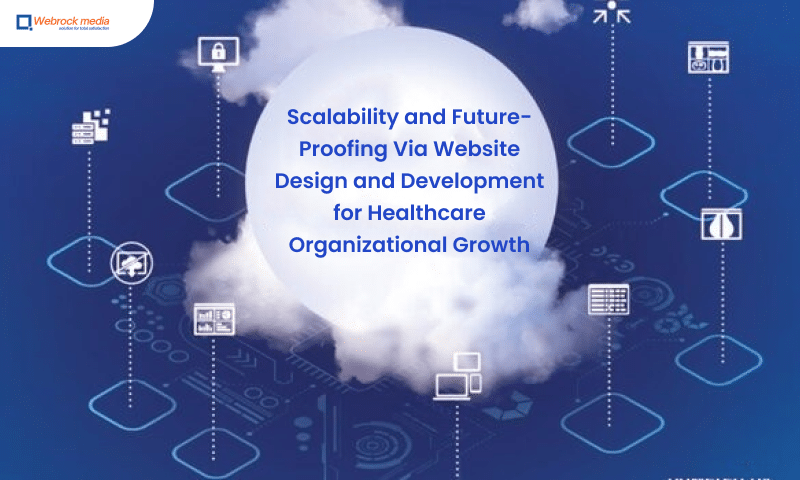
Scalability and future-proofing are essential considerations in website design and development for healthcare organizations to accommodate growth and evolving needs. Here are some strategies employed by Webrock Media to ensure scalability and future-proofing:
- Flexible Architecture:
Design the website with a flexible and modular architecture that allows for easy expansion and addition of new functionalities. This ensures that the website can adapt to future requirements without requiring a complete overhaul.
- Scalable Hosting Infrastructure:
Select a hosting solution that offers scalability and can handle increased traffic and data storage as the organization grows. Cloud-based hosting platforms, for example, provide the ability to scale resources up or down based on demand, ensuring optimal performance during peak periods.
- Content Management System (CMS):
Implement a robust CMS that allows for easy content updates and scalability. A flexible CMS enables healthcare organizations to add new pages, create additional sections, and manage growing content volumes without difficulty. Consider CMS platforms that have a strong track record of continuous development and updates.
- Responsive Design:
Ensure the website is designed with a responsive approach, optimizing its display across various devices and screen sizes. This adaptability is vital as the use of mobile devices continues to rise. A responsive design eliminates the need for separate mobile and desktop versions of the website, streamlining maintenance and future updates.
- API Integration:
Integrate the website with application programming interfaces (APIs) to facilitate seamless integration with external systems and services. This allows for future integration with new technologies, such as electronic health record (EHR) systems, appointment scheduling platforms, telemedicine services, and more.
- Scalable Database Structure:
Design the database structure with scalability in mind. Ensure it can handle increasing amounts of data and provide efficient querying and retrieval mechanisms. Use indexing, caching, and other optimization techniques to enhance database performance as the website and data volumes grow.
- Future-Proof Technologies:
Utilize modern and future-proof technologies in the website development process. Stay up to date with emerging industry standards, best practices, and technological advancements. This includes using well-established programming languages, frameworks, and libraries that have active developer communities and a roadmap for future updates and enhancements.
- Regular Updates and Maintenance:
Perform regular updates and maintenance tasks to ensure the website’s compatibility with new web standards, security patches, and software updates. This helps safeguard the website’s stability, security, and compatibility with evolving technologies.
- Collaboration and Partnership:
Foster a collaborative partnership with Webrock Media to stay informed about new trends, technologies, and opportunities for website improvement. Maintain regular communication to discuss organizational growth strategies and align website development plans with the healthcare organization’s long-term goals.
- Analytics and Data-Driven Insights:
Utilize website analytics and data-driven insights to monitor user behavior, identify trends, and make informed decisions for future enhancements. Analyze user engagement, conversion rates, and other relevant metrics to optimize the website’s performance and user experience continually.
By implementing these strategies, Webrock Media can help healthcare organizations ensure scalability, adaptability, and future-proofing of their websites. This enables seamless growth, enhanced user experiences, and the ability to leverage emerging technologies as the organization evolves.
Why Choose Webrock Media for Healthcare Website Design and Development?
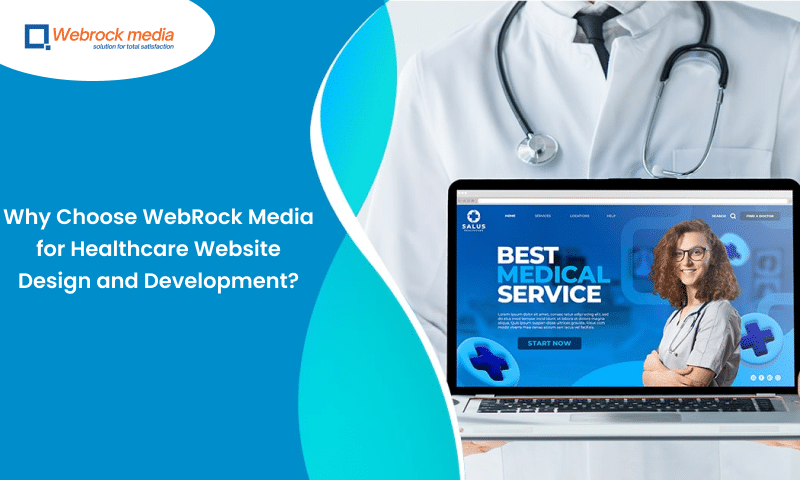
Choosing Webrock Media for healthcare website design brings the benefits of industry expertise, user-centric design, technical excellence, SEO integration, compliance and security measures, ongoing support, and a seamless client experience.
- Extensive Healthcare Expertise for Specialized Solutions:
Webrock Media has in-depth knowledge and experience in the healthcare industry, allowing them to understand the unique needs and requirements of healthcare organizations. They can provide tailored solutions that cater specifically to the healthcare sector, including functionalities, features, and design elements that are relevant and beneficial to healthcare websites.
- User-Focused Approach for Enhanced Usability:
Webrock Media prioritizes the user experience when designing healthcare websites. They understand the importance of creating intuitive and user-friendly interfaces that make it easy for patients, healthcare professionals, and other stakeholders to navigate the website and access the information they need. By focusing on usability, they ensure that visitors have a positive experience and can efficiently interact with the website.
- Technical Excellence in Website Design and Development:
Webrock Media excels in the technical aspects of website design and development. They possess the necessary skills and expertise to create visually appealing and functional websites that are optimized for performance, responsiveness, and compatibility across different devices and browsers. Their technical proficiency ensures a seamless and engaging user experience.
- Strategic SEO Integration for Increased Online Presence:
Webrock Media understands the importance of search engine optimization (SEO) in improving the online visibility and discoverability of healthcare websites. They integrate SEO strategies into the website design and development process, such as keyword research, on-page optimization, and content optimization, to enhance organic search rankings and attract targeted traffic.
- Compliance and Security for Data Protection:
Webrock Media is well-versed in the regulatory requirements of the healthcare industry, including data protection and privacy regulations like HIPAA. They prioritize compliance and ensure that healthcare websites they design and develop adhere to the necessary security and privacy measures to protect patient data and meet industry standards.
- Ongoing Support for a Hassle-Free Experience:
Webrock Media provides comprehensive ongoing support and maintenance services to healthcare organizations. This includes regular updates, security monitoring, bug fixes, and content management, ensuring that the website remains secure, up to date, and optimized for performance. Their support services offer a hassle-free experience for healthcare organizations, allowing them to focus on their core operations while entrusting their website’s maintenance to experts.
Contact Us for Your Healthcare Website Design Needs: Webrock Media invites healthcare organizations to get in touch for their healthcare website design requirements. They are available to discuss specific project needs, provide consultations, and offer customized solutions tailored to the unique needs and goals of each healthcare organization.
Call us today to discuss your healthcare website design and development needs. Let us help you create a compelling online presence that enhances patient engagement, builds trust, and drives the success of your healthcare business.

I hope you enjoy reading this blog post.
Would you like to get expert advice? Schedule a Call
About Webrock Media
Webrock Media comes with an incredible team of website and mobile application developers who can customize the perfect solutions to transform your business. We think ourselves to be an ideal ‘Technology Simplified Destination’ as we know how to perfectly merge creativity and programming to build robust websites for our clients.
